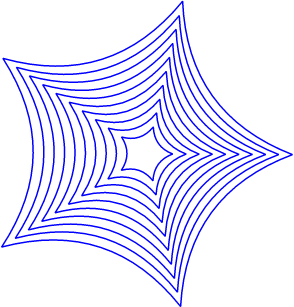 |
The Reuleaux Triangle is known for its curved sides of constant width and is one of the most superb graphics to animate as shown here. Created in RISC OS BASIC the original code comes from Steve Drain who developed the alternative keywords module - Basalt to enhance BBC BASIC V.
| Section # | Contents |
| 1 | Website Purpose |
| Hardware/Software Requirements | |
| Important Hardware Note | |
| Screen Mode | |
| Co-ordinates | |
| 2 | Getting Started with Graphics |
| 3 | Creating Geometric Shapes With PLOT Command |
| 4 | Shapes and Patterns |
| 5 | Other Graphic Designs |
| 6 | Animated Patterns |
| 7 | 3D Patterns |
| 8 | Parametric Equations |
| 9 | Tutorial - Creating a sprite animation |
| 10 | Reserved |
| 11 | Reserved |
| 12 | Appendix |
| 13 | Acknowledgements |
Notes:
- Use contents table to navigate the relevant links.
- Section 1 contains short paragraphs covering hardware and software details.
- Section 2 and 3 (italics) explain how the various geometric shapes are created. Read these if you are unfamiliar with RISC OS BASIC graphic keywords.
- Section 4-6 implement ideas outlined in the two previous sections to create some interesting shapes.
- Section 8 outlines the beauty and simplicity of parametric equations.
- The appendix contains all PLOT commands including offsets.
- Sections greyed out are planned/reserved for future dates

5-Point Deltoid

Simple Colour Animation Applied to a Segment Routine
1. Introduction
Website Purpose
The website is intended for any user who is interested in creating geometric art by programming. RISC OS BASIC is fast and rendering quality good with current ARM based hardware. Inspiration for these graphic programs comes from the excellent collection of "55 BBC Micro Books" from the Drag 'N Drop editor, Chris Dewhurst..............
Much of the material is still relevant to current versions of RISC OS. Changes to the original programs were necessary to ensure compatibility with Raspberry Pi/Hi Def monitors. All programs are single tasking running outside the desktop.
Hardware/Software Requirements
- Computer System: Raspberry Pi series computers
- Monitor type: HD widescreen, 1920 x 1080 resolution
- OS: All programs tested on RISC OS 5.24
- BASIC V version 1.75 interpreter (Built into RISC OS software)
- Text editor: recommend StrongED ( http://www.stronged.iconbar.com )
- BBC BASIC Reference Manual. A revised addition (Issue 2) was released in October 2017
Important Hardware Note
The graphics processor in the Raspberry Pi switches from the desktop to running a BASIC program instantly. Delays can occur with other hardware like R-Comp Interactive's ARMX6 but will still run.
Screen Mode
All program examples use a screen resolution of 1920 x 1080. This equates to a full HD widescreen monitor commonly available and giving the best graphic performance for the price. The MODE command commonly used in the tutorial is: MODE 1920,1080,32. The last parameter specifies the number of colours available. Also known as 'colour depth' this parameter equates to 32-bits/pixel producing 16 million colours (256*256*256). Other 'colour depth' parameters are 8-bits/pixel ie. 256 colours or 16-bits/pixel (32,000 colours).
More recent versions of BASIC enable user to code the resolution so that program can run automatically on any monitor. This is done by detecting the screen width and height and is fully explained in the BBC BASIC Reference Manual.
Co-ordinates
The screen co-ordinates are specified in OS units. The co-ordinates are referenced from the bottom left corner of the screen (x = 0, y = 0). Where the keyword, ORIGIN is used to set the screen centre to 1920,1080 the screen co-ordinates are specified from the screen centre.